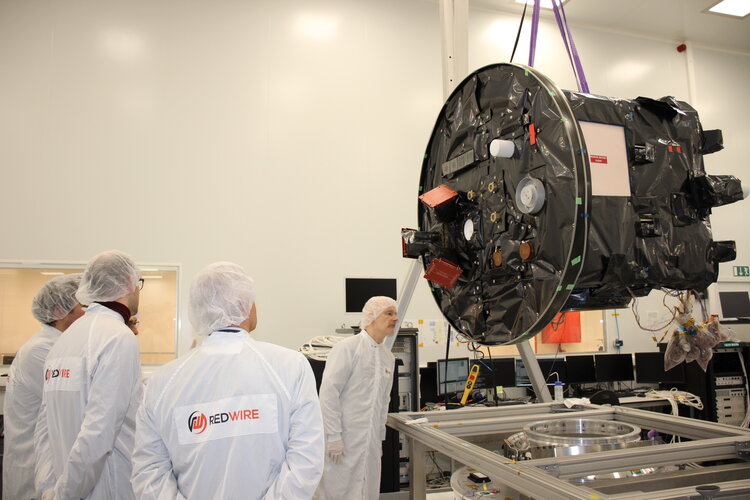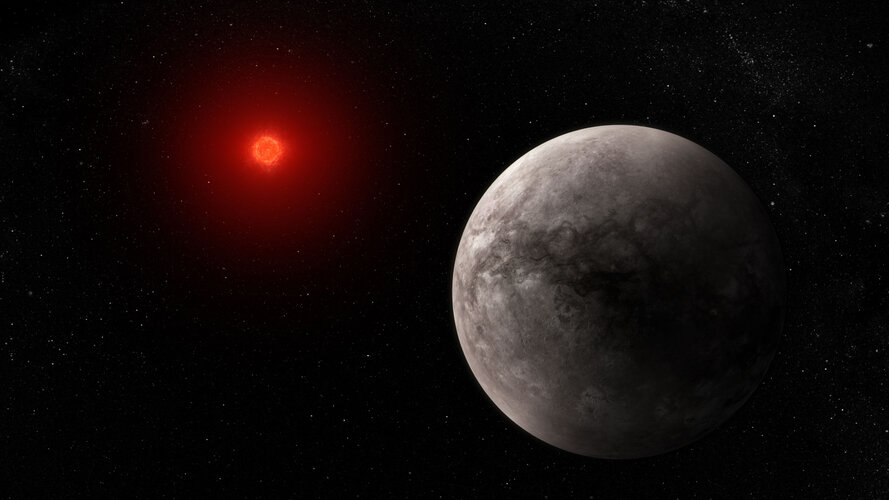
Copernical Team
Council approves senior management changes

At its 315th session on 22 and 23 March 2023, the ESA Council approved a series of nominations and extensions of contracts for ESA directors:
Proba-3 complete: Formation-flying satellites fully integrated

The two spacecraft forming ESA’s Proba-3 mission for precise formation flying in orbit are now complete. All the instruments and sensors allowing them to manoeuvre to millimetre scale precision relative to one another have been integrated aboard, and the pair are fully wrapped in multi-layer insulation – ready to be tested in simulated space conditions.
Webb measures the temperature of a rocky exoplanet

An international team of researchers has used the NASA/ESA/CSA James Webb Space Telescope to measure the temperature of the rocky exoplanet TRAPPIST-1 b. The measurement is based on the planet’s thermal emission: heat energy given off in the form of infrared light detected by Webb’s Mid-Infrared Instrument (MIRI). The result indicates that the planet’s dayside has a temperature of about 500 kelvins (roughly 230°C), and suggests that it has no significant atmosphere.
Comtech validates 5G connection over satellite
 Comtech has announced in collaboration with three global technology leaders: Cloud Signals, Hellas Sat, and a leading Mobile Network Operator (MNO), that the companies successfully tested and validated 5G connectivity over a satellite network in Greece.
During the demonstration, a commercial 5G node was connected to the leading MNO's 5G testbed network and relayed over a satellite link pro
Comtech has announced in collaboration with three global technology leaders: Cloud Signals, Hellas Sat, and a leading Mobile Network Operator (MNO), that the companies successfully tested and validated 5G connectivity over a satellite network in Greece.
During the demonstration, a commercial 5G node was connected to the leading MNO's 5G testbed network and relayed over a satellite link pro Dhruva and Kineis to offer satellite-based services
 India-based full-stack space-engineering solutions provider Dhruva Space and France-based satellite operator and global connectivity provider Kineis have inked a Memorandum of Agreement (MoA), marking a partnership where both companies will collaborate to establish space and ground infrastructure to scale the diversity and impact of satellite-based solutions.
With 9 satellites in orbit, Ki
India-based full-stack space-engineering solutions provider Dhruva Space and France-based satellite operator and global connectivity provider Kineis have inked a Memorandum of Agreement (MoA), marking a partnership where both companies will collaborate to establish space and ground infrastructure to scale the diversity and impact of satellite-based solutions.
With 9 satellites in orbit, Ki Kongsberg NanoAvionics to build more 5G Narrowband-IoT satellites for LEO constellation
 Washington DC (SPX) Mar 24, 2023
Smallsat mission integrator and bus manufacturer Kongsberg NanoAvionics (NanoAvionics) has received an order for three further satellites from 5G telecoms operator OQ Technology. They will be added to OQ Technology's existing constellation, turning the company into the largest 5G NB-IoT (narrowband Internet of things) satellite operator in the world.
It is
Washington DC (SPX) Mar 24, 2023
Smallsat mission integrator and bus manufacturer Kongsberg NanoAvionics (NanoAvionics) has received an order for three further satellites from 5G telecoms operator OQ Technology. They will be added to OQ Technology's existing constellation, turning the company into the largest 5G NB-IoT (narrowband Internet of things) satellite operator in the world.
It is Lynk selects Dawn Aerospace propulsion following an extensive industry trade study
 Dawn Aerospace, a leading space transportation company, reports that it has been selected to provide satellite propulsion systems for Lynk, the world's leading satellite-direct-to-standard-phone telecoms company. The partnership will enable Lynk to enhance deployment, life extension, collision avoidance, and de-orbit capabilities as its satellite constellation of 'cell towers in space' grows.
Dawn Aerospace, a leading space transportation company, reports that it has been selected to provide satellite propulsion systems for Lynk, the world's leading satellite-direct-to-standard-phone telecoms company. The partnership will enable Lynk to enhance deployment, life extension, collision avoidance, and de-orbit capabilities as its satellite constellation of 'cell towers in space' grows. Sidus Space to power maritime solutions with AIS integration in LizzieSat
 Sidus Space, Inc. (NASDAQ:SIDU), a Space-as-a-Service satellite company focused on mission-critical hardware manufacturing; multi-disciplinary engineering services; satellite design, production, launch planning, mission operations; and in-orbit support, announced an agreement with SatLab to implement its second-generation automated identification system (AIS) technology into the Company's Lizzie
Sidus Space, Inc. (NASDAQ:SIDU), a Space-as-a-Service satellite company focused on mission-critical hardware manufacturing; multi-disciplinary engineering services; satellite design, production, launch planning, mission operations; and in-orbit support, announced an agreement with SatLab to implement its second-generation automated identification system (AIS) technology into the Company's Lizzie Guerrilla RF achieves rapid verification of designs for high-growth markets
 Guerrilla RF, Inc. (OTCQX: GUER), a leading provider of state-of-the-art RF and microwave communications solutions, has announced that its robust 2022 investments in research and development (R and D) produced a 33% increase in its number of engineering tape-outs-from 31 tape-outs in 2021 to 41 in 2022-all targeting the high-growth 5G, cellular booster, automotive, and satellite communications m
Guerrilla RF, Inc. (OTCQX: GUER), a leading provider of state-of-the-art RF and microwave communications solutions, has announced that its robust 2022 investments in research and development (R and D) produced a 33% increase in its number of engineering tape-outs-from 31 tape-outs in 2021 to 41 in 2022-all targeting the high-growth 5G, cellular booster, automotive, and satellite communications m OQ Technology to become world's largest 5G NB-IoT LEO-satellite operator
 OQ Technology, the world's first and only satellite operator of a 5G NB-IoT constellation, plans to grow its constellation from three to ten satellites in low Earth orbit (LEO) this year. The move will turn the company into the largest 5G NB-IoT satellite operator in the world.
The seven satellites that will be added to OQ Technology's constellation, are the previously announced "MACSAT" a
OQ Technology, the world's first and only satellite operator of a 5G NB-IoT constellation, plans to grow its constellation from three to ten satellites in low Earth orbit (LEO) this year. The move will turn the company into the largest 5G NB-IoT satellite operator in the world.
The seven satellites that will be added to OQ Technology's constellation, are the previously announced "MACSAT" a 
